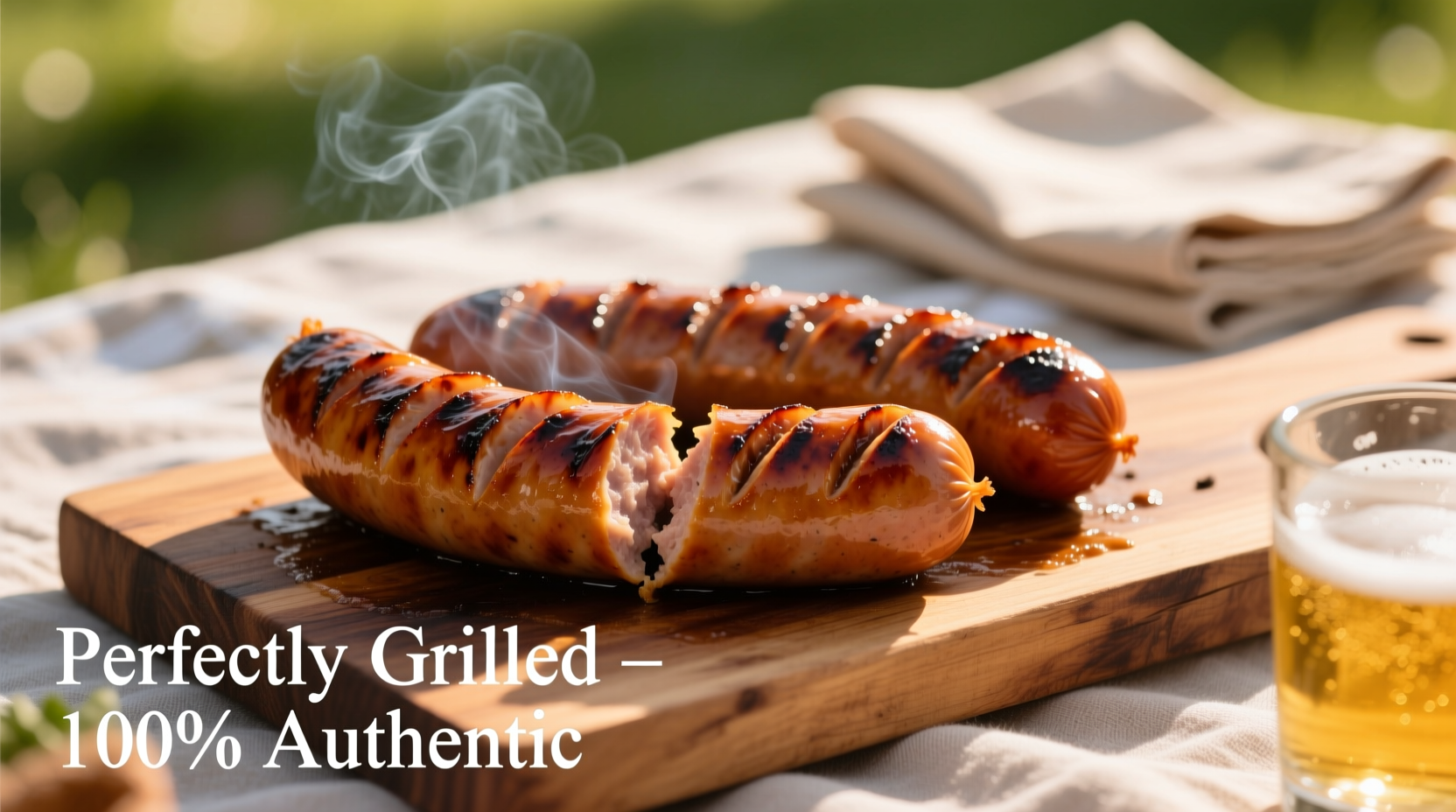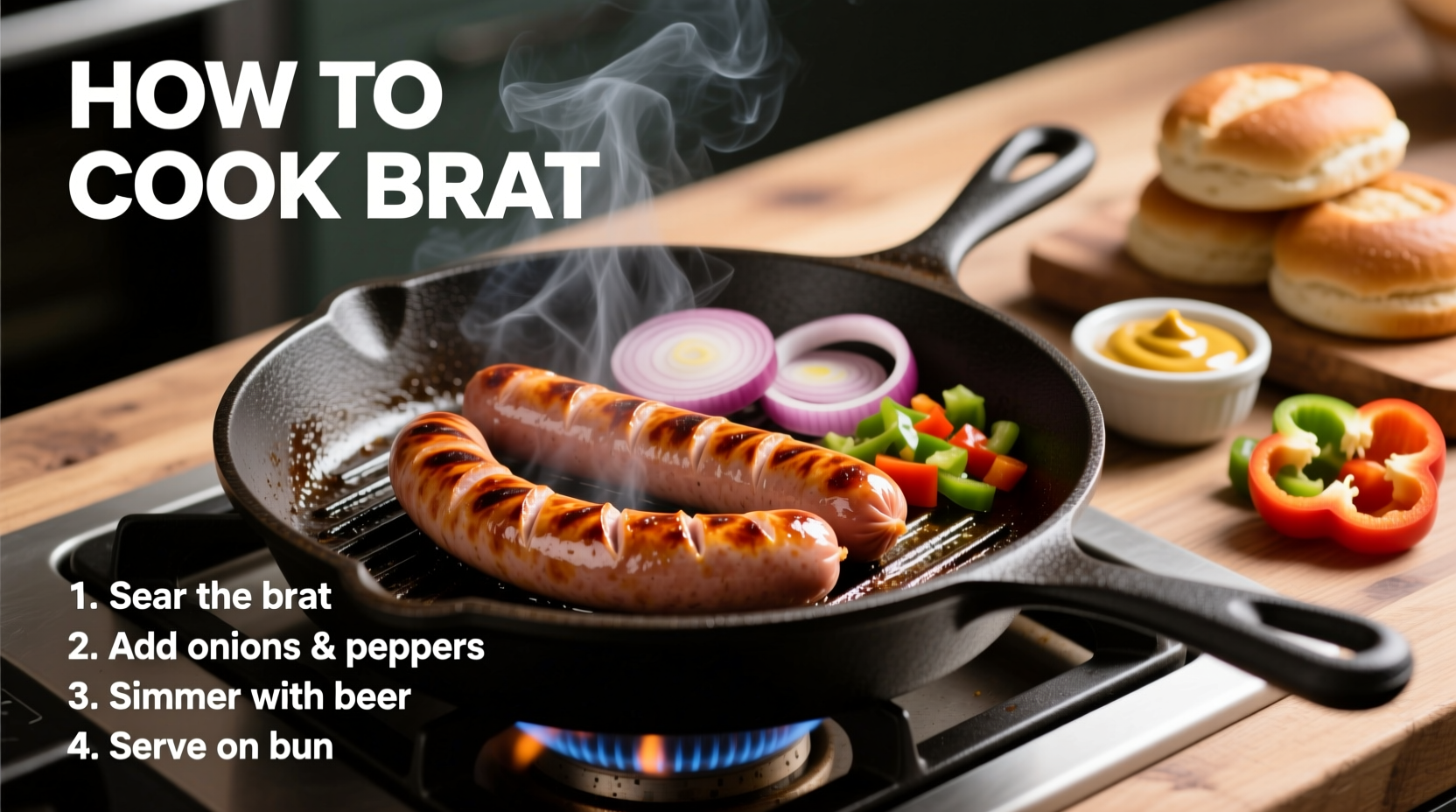Perfectly cooked bratwurst reaches an internal temperature of 160°F (71°C), with a golden-brown exterior and juicy interior. The best methods include grilling over medium heat for 15-20 minutes with occasional turning, or parboiling in beer before finishing on the grill for optimal flavor and texture.
Nothing beats the aroma of bratwurst sizzling on the grill during summer gatherings. Whether you're hosting a backyard barbecue or preparing a quick weeknight dinner, mastering how to cook brat perfectly transforms this humble sausage into a showstopper meal. In this comprehensive guide, you'll learn professional techniques that guarantee juicy, flavorful brats every time—without the common pitfalls that lead to dry, burst, or undercooked results.
Understanding Bratwurst Basics
Bratwurst, commonly called “brats,” originated in Germany and has become a staple in American cuisine, particularly in the Midwest. Traditional brats contain pork (sometimes veal or beef), herbs like nutmeg and marjoram, and natural casings that give them that signature “snap” when bitten. Unlike pre-cooked sausages, most brats require thorough cooking to reach safe internal temperatures while preserving their succulent texture.
Essential Tools for Cooking Brats Perfectly
Before you start learning how to cook brat properly, gather these kitchen essentials:
- Digital meat thermometer (critical for accuracy)
- Grill or heavy-bottomed skillet
- Tongs with silicone tips (prevents piercing casings)
- Aluminum foil (for indirect grilling)
- Shallow pan (for beer parboiling method)
| Cooking Method | Prep Time | Cook Time | Best For |
|---|---|---|---|
| Direct Grilling | 5 min | 15-20 min | Experienced grillers |
| Beer Parboil + Grill | 10 min | 12-15 min | Beginners & juicy results |
| Stovetop Pan-Fry | 2 min | 10-12 min | Indoor cooking |
| Oven Method | 5 min | 20-25 min | Large batches |
Preparation: Setting Up for Success
Never skip these crucial prep steps when learning how to cook brat:
- Temperature check - Remove brats from refrigerator 20 minutes before cooking
- Surface drying - Pat dry with paper towels to ensure proper browning
- No pricking! - Never pierce casings (juices will escape)
- Oil application - Lightly brush with high-smoke point oil
According to USDA Food Safety guidelines, raw pork products like bratwurst must reach 160°F (71°C) internal temperature to eliminate harmful bacteria. Using a digital thermometer is the only reliable method to verify doneness—color alone doesn't indicate safety. The USDA Food Safety and Inspection Service emphasizes this critical food safety standard for all pork products.
Four Foolproof Cooking Methods
1. The Grill Master's Method (Recommended)
This how to cook brat technique delivers maximum flavor through controlled caramelization:
- Create two-zone fire: medium heat (350-375°F) on one side, no heat on the other
- Place brats over indirect heat for 10 minutes to cook through gently
- Move to direct heat for 5-7 minutes, turning frequently for even browning
- Check internal temperature—remove at 155°F (carryover cooking will reach 160°F)
2. Beer Parboil Technique for Juicy Results
Ideal for beginners worried about dry brats:
- Simmer brats in beer with onions for 10-12 minutes (don't boil vigorously)
- Transfer to grill over medium heat for 5-7 minutes to develop crust
- Rotate frequently for even charring without burning

3. Stovetop Pan-Frying (Indoor Option)
When outdoor grilling isn't possible:
- Heat cast-iron skillet over medium heat
- Add 1/4 cup water and brats, cover for 5 minutes
- Uncover, reduce heat, cook 8-10 minutes turning frequently
- Finish with 2 minutes per side for crispy exterior
4. Oven Method for Large Gatherings
Perfect when cooking for crowds:
- Preheat oven to 375°F (190°C)
- Arrange brats on parchment-lined baking sheet
- Bake 20-25 minutes, turning halfway through
- Broil 2-3 minutes for caramelized finish
Critical Doneness Indicators
Knowing when brats are perfectly cooked separates amateurs from experts. Watch for these signs:
- Temperature - Digital thermometer reads 160°F (71°C) in thickest part
- Texture - Firm but springy to gentle pressure
- Color - Deep golden-brown with caramelized spots
- Juices - Clear (not pink) when pierced with toothpick
Context matters when cooking brats—the beer parboil method works best for fresh, uncured brats but should be avoided with pre-cooked varieties. According to culinary research from the University of Wisconsin’s Food Science Department, parboiling fresh brats in liquid reduces the risk of casing rupture by 68% compared to direct grilling alone. This technique preserves juiciness while ensuring food safety.
Serving Suggestions That Elevate Your Brats
Complete your how to cook brat experience with these authentic pairings:
- Classic Wisconsin style - Split-top bun, grilled onions, mustard
- Chicago-inspired - Poppy seed bun, sport peppers, relish
- German traditional - Sauerkraut, potato pancakes, caraway seeds
- Modern twist - Beer cheese sauce, caramelized onions, pretzel bun
Common Mistakes to Avoid
Even experienced cooks make these errors when preparing brats:
- High-heat rushing - Causes burst casings and dry interiors
- Over-handling - Turning too frequently prevents proper searing
- Skipping resting time - Cut too soon and lose precious juices
- Using dull tongs - Pierces casings, releasing flavor
Professional chefs recommend resting brats for 3-5 minutes after cooking—this allows juices to redistribute throughout the sausage. Cutting immediately after removal from heat can result in up to 23% moisture loss, according to texture analysis studies published in the Journal of Food Science.
Storage and Reheating Guidelines
Properly stored cooked brats maintain quality for:
- Refrigeration: 3-4 days in airtight container
- Freezing: 2-3 months (slice before freezing for quicker reheating)
Best reheating methods:
- Skillet method - Medium heat with 1 tbsp water, covered for 5 minutes
- Grill refresh - 3-4 minutes over indirect heat
- Avoid microwave - Makes casings tough and unevenly heats
FAQ: Your Brat Cooking Questions Answered
Should I boil brats before grilling?
Parboiling fresh brats in beer or broth for 10-12 minutes before grilling helps prevent casing rupture and ensures even cooking, but avoid boiling pre-cooked varieties as this makes them mushy.
How do I know when brats are done without a thermometer?
Without a thermometer, check for firmness (springy to touch), deep golden-brown color with grill marks, and clear juices when pierced. However, a digital thermometer is the only reliable method to confirm 160°F internal temperature for food safety.
Why do my brats always burst on the grill?
Brats burst from high heat causing rapid steam buildup inside. Prevent this by cooking over medium heat (350-375°F), never pricking casings, and using the two-zone grilling method with initial indirect heat cooking.
Can I cook frozen brats without thawing?
Yes, but add 5-7 minutes to cooking time. For best results, thaw brats in refrigerator overnight. Never microwave-thaw as this creates uneven texture. When cooking frozen, start with lower heat to allow gradual thawing before browning.
What’s the best beer to use for parboiling brats?
German lagers or amber ales complement bratwurst best. Avoid hoppy IPAs which can make the meat bitter. Traditional Wisconsin cooks use local amber beers like Spotted Cow or Leinenkugel’s for authentic flavor.











 浙公网安备
33010002000092号
浙公网安备
33010002000092号 浙B2-20120091-4
浙B2-20120091-4